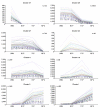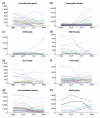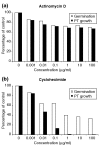Transcriptome analysis of haploid male gametophyte development in Arabidopsis
- PMID: 15535861
- PMCID: PMC545776
- DOI: 10.1186/gb-2004-5-11-r85
Transcriptome analysis of haploid male gametophyte development in Arabidopsis
Abstract
Background: The haploid male gametophyte generation of flowering plants consists of two- or three-celled pollen grains. This functional specialization is thought to be a key factor in the evolutionary success of flowering plants. Moreover, pollen ontogeny is also an attractive model in which to dissect cellular networks that control cell growth, asymmetric cell division and cellular differentiation. Our objective, and an essential step towards the detailed understanding of these processes, was to comprehensively define the male haploid transcriptome throughout development.
Results: We have developed staged spore isolation procedures for Arabidopsis and used Affymetrix ATH1 genome arrays to identify a total of 13,977 male gametophyte-expressed mRNAs, 9.7% of which were male-gametophyte-specific. The transition from bicellular to tricellular pollen was accompanied by a decline in the number of diverse mRNA species and an increase in the proportion of male gametophyte-specific transcripts. Expression profiles of regulatory proteins and distinct clusters of coexpressed genes were identified that could correspond to components of gametophytic regulatory networks. Moreover, integration of transcriptome and experimental data revealed the early synthesis of translation factors and their requirement to support pollen tube growth.
Conclusions: The progression from proliferating microspores to terminally differentiated pollen is characterized by large-scale repression of early program genes and the activation of a unique late gene-expression program in maturing pollen. These data provide a quantum increase in knowledge concerning gametophytic transcription and lay the foundations for new genomic-led studies of the regulatory networks and cellular functions that operate to specify male gametophyte development.
Figures





Similar articles
-
Genome-scale analysis and comparison of gene expression profiles in developing and germinated pollen in Oryza sativa.BMC Genomics. 2010 May 28;11:338. doi: 10.1186/1471-2164-11-338. BMC Genomics. 2010. PMID: 20507633 Free PMC article.
-
Comprehensive analysis of tobacco pollen transcriptome unveils common pathways in polar cell expansion and underlying heterochronic shift during spermatogenesis.BMC Plant Biol. 2012 Feb 16;12:24. doi: 10.1186/1471-2229-12-24. BMC Plant Biol. 2012. PMID: 22340370 Free PMC article.
-
Combinatorial interactions between LBD10 and LBD27 are essential for male gametophyte development in Arabidopsis.Plant Signal Behav. 2015;10(8):e1044193. doi: 10.1080/15592324.2015.1044193. Plant Signal Behav. 2015. PMID: 26252070 Free PMC article.
-
Male gametophyte development: a molecular perspective.J Exp Bot. 2009;60(5):1465-78. doi: 10.1093/jxb/ern355. Epub 2009 Feb 12. J Exp Bot. 2009. PMID: 19213812 Review.
-
Male gametogenesis and germline specification in flowering plants.Sex Plant Reprod. 2011 Jun;24(2):149-60. doi: 10.1007/s00497-010-0157-5. Epub 2010 Nov 20. Sex Plant Reprod. 2011. PMID: 21103996 Review.
Cited by
-
A transcriptional dynamic network during Arabidopsis thaliana pollen development.BMC Syst Biol. 2011;5 Suppl 3(Suppl 3):S8. doi: 10.1186/1752-0509-5-S3-S8. Epub 2011 Dec 23. BMC Syst Biol. 2011. PMID: 22784627 Free PMC article.
-
Rapid separation of Arabidopsis male gametophyte developmental stages using a Percoll gradient.Nat Protoc. 2016 Oct;11(10):1817-32. doi: 10.1038/nprot.2016.107. Epub 2016 Sep 1. Nat Protoc. 2016. PMID: 27583643
-
Starch Turnover and Metabolism during Flower and Early Embryo Development.Plant Physiol. 2016 Dec;172(4):2388-2402. doi: 10.1104/pp.16.00916. Epub 2016 Oct 28. Plant Physiol. 2016. PMID: 27794100 Free PMC article.
-
Dynamics of the Pollen Sequestrome Defined by Subcellular Coupled Omics.Plant Physiol. 2018 Sep;178(1):258-282. doi: 10.1104/pp.18.00648. Epub 2018 Jul 14. Plant Physiol. 2018. PMID: 30007911 Free PMC article.
-
PIRL1 and PIRL9, encoding members of a novel plant-specific family of leucine-rich repeat proteins, are essential for differentiation of microspores into pollen.Planta. 2010 Oct;232(5):1101-14. doi: 10.1007/s00425-010-1242-6. Epub 2010 Aug 10. Planta. 2010. PMID: 20697737
References
Publication types
MeSH terms
Substances
LinkOut - more resources
Full Text Sources
Other Literature Sources
Molecular Biology Databases

